First Look at the Zeiss Milvus 35mm f/1.4
Related: bokeh, color bokeh, distortion, Eastern Sierra, external articles by Lloyd, field curvature, focus stacking, focusing, How-To, Lundy Canyon area, optics, peak bagging, visual impact, Zeiss, Zeiss 35mm f/1.4 Distagon, Zeiss Distagon, Zeiss DSLR Lenses, Zeiss Lenses, ZEISS Lenspire, Zeiss Milvus, Zeiss Milvus 35mm f/1.4
by Lloyd Chambers, diglloyd.com
Zeiss provided a pre-production sample of the Milvus 35/1.4 for this first look and overview. Over the course of a few weeks using the 50-megapixel Canon 5Ds R, I shot the Milvus 35/1.4 alongside its ZE 35/1.4 predecessor and also the Canon 35mm f/1.4L II, making a wide variety of comparisons near and far of landscapes, buildings and interiors, looking to thoroughly understand image quality and operational characteristics. See my in-depth reviews of Zeiss DSLR lenses at diglloyd.com.
The Milvus 35/1.4 seems to be the 35mm lens everyone wanted from Zeiss all these years: in magnified Live View, it immediately stands out for its ease of focusing as a major step forward, offering a much crisper image at f/1.4 that is free of the longitudinal chromatic veiling haze of its predecessor. The Milvus 35/1.4 banishes both violet fringing and out-of-focus magenta/green “color bokeh” blurs, and delivers the best-yet color correction among fast Zeiss wide angles, excepting the Otus 28/1.4 APO-Distagon. Its consistent across-the-field sharpness results from tightly controlled field curvature, with a much flatter field than its predecessor. By f/2.8 to f/4, the Milvus 35/1.4 delivers sharpness corner to corner that was not possible at any aperture with the ZE 35/1.4. Its performance is similar to a longtime favorite of mine, the Zeiss ZM 35mm f/1.4 Distagon, although the Milvus takes performance a step further by having even less field curvature (consistently higher performance across the field, in a plane).
Bokeh and rendering style with the Milvus 35/1.4 is exceptionally smooth and free from any harsh effects near or far, defining subjects in a classic Zeiss 3-dimensional look. While I found its peak sharpness wide open to be somewhat less than the Canon 35/1.4L II, its performance is more consistent over the frame, and it offers a smoother and more pleasing background bokeh with superior color correction, particularly in outer zones. Zeiss did not provide any specifications, but my (technically incorrect) impression is that only spherical lens elements are used (no aspherics), because in none of my images did the background bokeh shows any of the double-image bokeh so common with aspheric designs. Its rendering style along with its excellent focusing throw and feel might make it a favorite of videographers and still shooters alike.
Color rendition of lenses when shooting at wider apertures is often mostly about secondary color: in general I would say that the Milvus 35/1.4 feels “warm”, lacking the cool (blue/green) tendency of other brands I have used. The strict color correction banishes any bluish haze at f/1.4, and also means that out of focus background areas avoid most of the greenish tint of less well corrected lenses. This contributes to a natural color balance that is subtle but unmistakable, something that imbues images with a distinct signature.
- Wide open sharpness is strong across the field even to the edges, at moderate contrast (micro contrast is very good but not Otus grade). Stopping down quickly brings world-class razor sharp results with very high micro contrast by f/2.8 - f/4. By f/4 it rivals the best wides like the Otus 28/1.4 APO-Distagon.
- Outstanding bokeh free of color effects, exceptionally smooth and free of any double image or other negatives.
- Color correction is the best I’ve yet seen in a non-Otus Zeiss wide angle, about as close to Otus grade as one might hope for. The absence of violet haloes and near freedom from background “color bokeh” lends a clarity and realistic look to images that takes some shooting to appreciate (and that won’t show up in lab tests) but it’s very important to the visual impact.
- Exceptionally well controlled field curvature (“flat field”) making it ideal for planar subject (distance scenes, groups of people, architecture, etc).
- Freedom from focus shift and freedom from violet fringing making focusing wide open in magnified Live View a quick and enjoyable task—what you see is what you get—perfect!
- Well controlled distortion for an f/1.4 lens (critical subjects might require correction of moderate barrel distortion).
While it’s a superb lens for stills, I’d guess that video shooters will adore the Milvus 35/1.4 for its excellent focus throw and gorgeous rendering.
Example with thee 35mm Lenses
These three images were taken with the Milvus 35/1.4, ZE 35/1.4 Distagon, and Canon 35/1.4L II.
All three lenses have strong visual impact. Differences are found in field of view, peak sharpness and sharpness across the field, localized contrast and haze (or lack of haze) and secondary color blurs in out-of-focus areas. See the crop for one aspect, or see the large-size images.
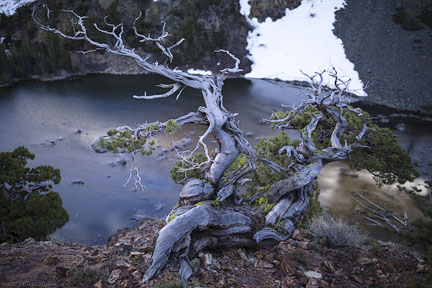
Canon EOS 5DS R + Zeiss Milvus 35mm f/1.4
[low-res image for bot]
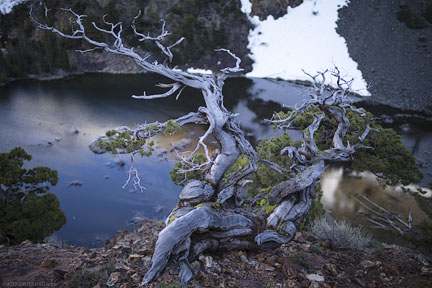
Canon EOS 5DS R + Zeiss 35mm f/1.4 Distagon
[low-res image for bot]
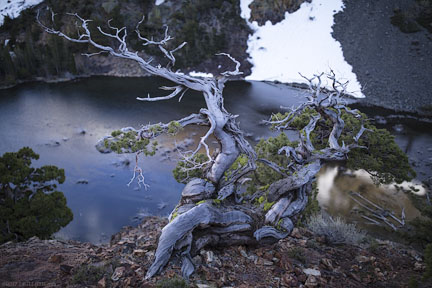
Canon EOS 5DS R + Canon EF 35mm f/1.4L II
[low-res image for bot]
Bokeh compared
Bokeh (out of focus rendering style) is a sum total effect of a defocused shape but also any secondary color blurs, edge effects, etc. Rendering style may be of particular interest to videographers or still shooters frequently shooting at f/1.4 through f/2.8. My sense of it is that secondary color errors are undesirable to the point of being the most important bokeh factor of all, because uncorrected secondary color overlays and destroys the original color of the subject.
For example, the bleached white logs in blue light in this crop are rendered by the ZE 35/1.4 as saturated magenta/green shapes which do not exist in reality. By comparison, the Milvus 35/1.4 offers an exceptionally 'clean' bokeh in both uniformity, freedom from harsh edges and strict control of color aberrations. And while it does not completely banish secondary color and is not designated by Zeiss as APO, it is nonetheless ranks among the very best 35mm lenses for color correction.
Below, the magenta/green color blurs of secondary longitudinal chromatic aberration are prominent with the ZE 35/1.4 but the Milvus 35/1.4 banishes these color aberrations while also delivering smooth shapes with no hard edges or edge/center harshness—natural looking. The Canon 35/1.4L II shows a “harder” bokeh in which shapes have a core/edge effect that looks like two objects instead of one—such effects are less pleasing to the eye and slightly distracting.
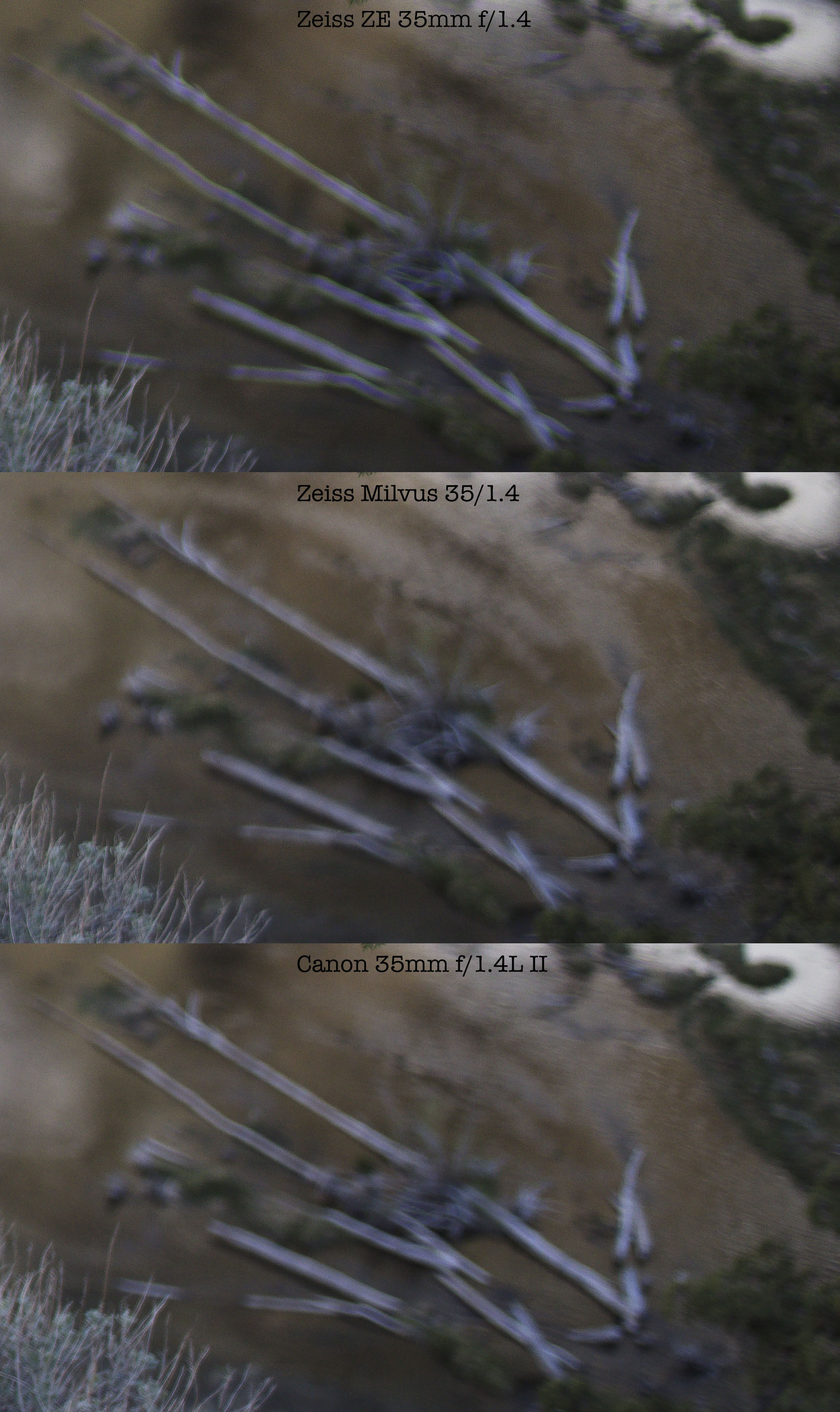
Rendering style examples
These images are best viewed on an iMac 5K at actual pixels, for a stunning visual impact.
By f/2.8 the Milvus 35/1.4 delivers outstanding world-class contrast which is eminently suitable for black and white conversions. Here a single exposure at f/4.5 was used for a bit more depth of field. This image demands a wide dynamic range (Canon 5Ds R not really up to the task!) in which shadows were boosted considerably and highlights pulled down. The very high lens contrast delivers a 3D effect to the image, with the depth of field of f/4.5 perfectly balancing sharpness and blue to accentuate the 3D effect.
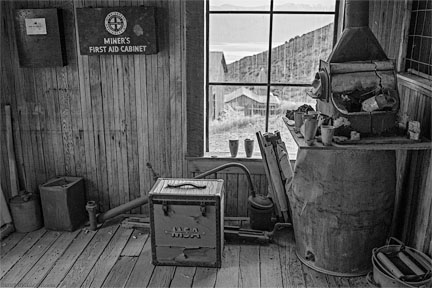
Canon EOS 5DS R + Zeiss Milvus 35mm f/1.4
[low-res image for bot]
The total rendering style of the Milvus 35/1.4 along with strictly controlled color aberrations makes it highly suitable for photography at dusk in blue light: shapes and colors remain free of color or shape distortions (see for example the out of focus house at left). This exceptionally natural look is seen in every image and it contributes to a strong separation of subject from background—a 3D effect.
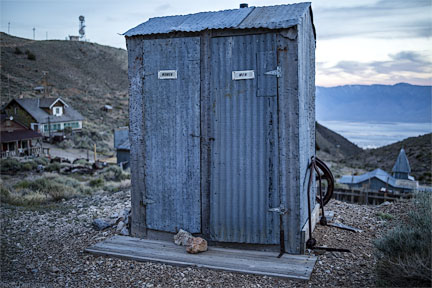
Canon EOS 5DS R + Zeiss Milvus 35mm f/1.4
[low-res image for bot]
At f/1.4, the Milvus 35/1.4 can reach into a scene and draw the eye thither. Stopped down (2nd image below), it makes an outstanding lens for focus stacking.

Canon EOS 5DS R + Zeiss Milvus 35mm f/1.4
[low-res image for bot]
Below, the use of focus stacking at f/9 delivers a crazy-sharp 50-megapixel image from right in front of the camera to the far distance; see Depth of Field Challenges: Bypass the Limits with Focus Stacking, Near or Far, Macro or Landscape. The Milvus 35/1.4 makes an outstanding lens for focus stacking.

Canon EOS 5DS R + Zeiss Milvus 35mm f/1.4
[low-res image for bot]
In blue light at dusk, the Milvus 35/1.4 remains free of violet/purple fringing and is free of haze all while maintaining excellent neutrality in blurred background areas (no magenta/green “color bokeh” to be seen).
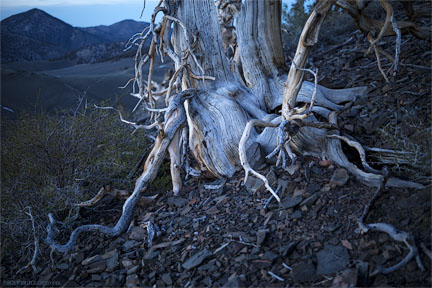
Canon EOS 5DS R + Zeiss Milvus 35mm f/1.4
[low-res image for bot]
Conclusions
The Zeiss Milvus 35mm f/1.4 is the 35mm DSLR lens Zeiss fans have been waiting for. As a major upgrade over its predecessor, it offers strict control of color aberrations wide open along with beautiful bokeh, and stopped down a bit, it delivers world-class sharpness far exceeding its ZE/ZF.2 predecessor.
Lloyd’s photography blog is found at diglloyd.com; it covers many brands, lenses, cameras. In-depth review coverage of the Zeiss DSLR lenses for Canon and Nikon is found in Guide to Zeiss DSLR Lenses. By subscription.

